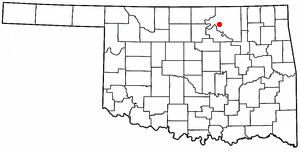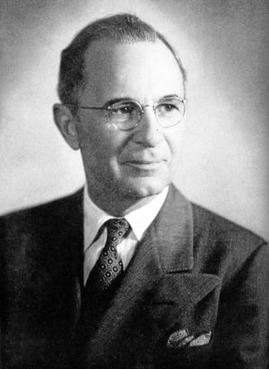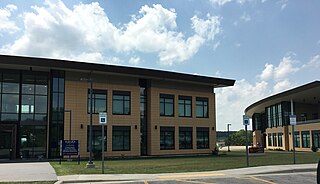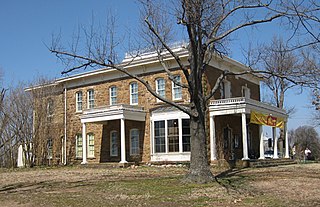
Pawnee County is a county located in the U.S. state of Oklahoma. As of the 2010 census, the population was 16,577. Its county seat is Pawnee. The county is named after the Pawnee Nation, whose reservation used to encompass the county prior to allotment in 1893.

Osage County is the largest county by area in the U.S. state of Oklahoma. Created in 1907 when Oklahoma was admitted as a state, the county is named for and is home to the federally recognized Osage Nation. The county is coextensive with the Osage Nation Reservation, established by treaty in the 19th century when the Osage relocated there from Kansas. The county seat is in Pawhuska, one of the first three towns established in the county. The total population of the county is 47,987.

Burbank is a town in western Osage County, Oklahoma, United States. The population was 141 at the 2010 census, a 9 percent decrease from the figure of 155 recorded in 2000.

Fairfax is a town in Osage County, Oklahoma, United States. The Osage Nation reservation is coterminous with the county. The population was 1,380 at the 2010 census, down 11.3 percent from the figure of 1,555 recorded in 2000. It is notable as the home of world-famous ballerinas Maria and Marjorie Tallchief.

William Thomas Gilcrease was an American oilman, art collector, and philanthropist. During his lifetime, Gilcrease collected more than 10,000 artworks, 250,000 Native American artifacts and 100,000 rare books and documents, including the only surviving certified copy of the Declaration of Independence. He was the founder of Gilcrease Museum in Tulsa, Oklahoma. In 1971, he was inducted into the Hall of Great Westerners of the National Cowboy & Western Heritage Museum.

The Osage Nation is a Midwestern Native American tribe of the Great Plains. The tribe developed in the Ohio and Mississippi river valleys around 700 BC along with other groups of its language family. They migrated west after the 17th century, settling near the confluence of the Missouri and Mississippi rivers, as a result of Iroquois invading the Ohio Valley in a search for new hunting grounds.
William N. Fenton was an American scholar and writer known for his extensive studies of Iroquois history and culture. He started his studies of the Iroquois in the 1930s and published a number of significant works over the following decades. His final work was published in 2002. During his career, Fenton was director of the New York State Museum and a professor of anthropology at the State University of New York.

The Five Civilized Tribes Museum in Muskogee, Oklahoma, showcases the art, history, and culture of the so-called "Five Civilized Tribes": the Cherokee, Chickasaw, Choctaw, Muscogee (Creek), and Seminole tribes. Housed in the historic Union Indian Agency building, the museum opened in 1966.

The Institute of American Indian Arts (IAIA) is a public tribal land-grant college in Santa Fe, New Mexico. The college focuses on Native American art. It operates the Museum of Contemporary Native Arts (MoCNA), which is housed in the historic Santa Fe Federal Building, a landmark Pueblo Revival building listed on the National Register of Historic Places as Federal Building. The museum houses the National Collection of Contemporary Indian Art, with more than 7,000 items.

The Crow Museum of Asian Art is a museum in downtown Dallas, Texas, dedicated to celebrating the arts and cultures of Asia including China, Japan, India, Korea, Nepal, Vietnam, Cambodia, Thailand, Indonesia, Myanmar and the Philippines, from ancient to the contemporary. The Crow Museum opened to the public on December 5, 1998, as a gift to the people and visitors of Dallas from Mr. and Mrs. Trammell Crow. The museum is a member of the Dallas Arts District. The interior was designed by Booziotis and Company Architects of Dallas.

John Joseph Mathews (Osage) became one of the Osage Nation's most important spokespeople and writers, and served on the Osage Tribal Council during the 1930s. He studied at the University of Oklahoma, Oxford University, and the University of Geneva after serving as a flight instructor during World War I.

Bacone College, formerly Bacone Indian University, is a private tribal college in Muskogee, Oklahoma. Founded in 1880 as the Indian University by missionary Almon C. Bacone, it was originally affiliated with the mission arm of what is now American Baptist Churches USA. Renamed as Bacone College in the early 20th century, it is the oldest continuously operated institution of higher education in Oklahoma. The liberal arts college has had strong historic ties to several tribal nations, including the Muscogee and Cherokee. The Bacone College Historic District has been on the National Register of Historic Places listings in Muskogee County, Oklahoma since 2014.

Gilcrease Museum, also known as the Thomas Gilcrease Institute of American History and Art, is a museum northwest of downtown Tulsa, Oklahoma housing the world's largest, most comprehensive collection of art of the American West, as well as a growing collection of art and artifacts from Central and South America. The museum is named for Thomas Gilcrease, an oil man and avid art collector, who began the collection. He deeded the collection, as well as the building and property, to the City of Tulsa in 1958. Since July 1, 2008, Gilcrease Museum has been managed by a public-private partnership of the City of Tulsa and the University of Tulsa. The Helmerich Center for American Research at Gilcrease Museum was added in 2014 at a cost of $14 million to provide a secure archival area where researchers can access any of the more than 100,000 books, documents, maps and unpublished materials that have been acquired by the museum.

The Mexican Museum is a museum created to exhibit the aesthetic expression of the Latino, Chicano, Mexican, and Mexican-American people, located in San Francisco, California, United States. As of 2022, their exhibition space was permanently closed at Fort Mason Center; and they are still in the process of moving to a new space at 706 Mission Street in Yerba Buena Gardens.

The National Museum of Myanmar (Yangon), (Burmese: အမျိုးသား ပြတိုက်), located in Dagon, Yangon, is the major one of the two national museums for Burmese art, history and culture in Myanmar. Founded in 1952, the five-storey museum has an extensive collection of ancient artifacts, ornaments, work of art, inscriptions and historic memorabilia, related to history, culture and civilization of Burmese people. The main attraction of the museum is the only surviving original Lion Throne of the Burmese monarchs. There are more than 4000 permanent objects in the museum.

The Arizona State Museum (ASM), founded in 1893, was originally a repository for the collection and protection of archaeological resources. Today, however, ASM stores artifacts, exhibits them and provides education and research opportunities. It was formed by authority of the Arizona Territorial Legislature. The museum is operated by the University of Arizona, and is located on the university campus in Tucson.
Daniel C. Swan is an American cultural anthropologist and museum curator whose work has focused on documenting and interpreting the cultural history of the Americas. He has specialized particularly on the histories, social organizations, and cultures of Native North American peoples in Oklahoma, USA. His research on the history, significance, and artistic forms of the Native American Church has led to research and exhibition collaborations with artists and elders in a diversity of American Indian communities, both in Oklahoma and elsewhere in the Western United States. In addition to his work on American Indian topics, he has organized exhibitions and museum catalogs about cultural diversity in the American West and in the Western Hemisphere more broadly.
Louis Francis Burns was an American historian, author, and teacher, known as a leading expert on the history, mythology and culture of the Osage Nation. Burns wrote more than a dozen books and scholarly works on the Osage people. In 2002 he was inducted into the Oklahoma Historians Hall of Fame.

Southern Plains Indian Museum is a Native American museum located in Anadarko, Oklahoma. It was opened in 1948 under a cooperative governing effort by the United States Department of the Interior and the Oklahoma state government. The museum features cultural and artistic works from Oklahoma tribal peoples of the Southern Plains region, including the Caddo, Chiricahua Apache, Comanche, Delaware Nation, Kiowa, Plains Apache, Southern Arapaho, Southern Cheyenne, and Wichita.
Scott Norris Bighorse is an Osage American politician. Between 2006 and 2008, Bighorse was a member of the Oklahoma House of Representatives from the 36th district. From 2010 to 2014, he served as assistant principal chief of the Osage Nation. Bighorse was elevated to interim principal chief of the Osage Nation after the 2014 impeachment of John Red Eagle and replaced later that year by Geoffrey Standing Bear. Bighorse was elected to the Osage Nation Congress in 2018.














